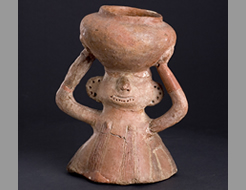|
||||||||||||||||||||||||||||||||
|
|
Museum of: Bucharest | |||||||||||||||||||||||||||||||
| Name of the artefact: Anthropomorphic statuette with pot on the head | ||||||||||||||||||||||||||||||||
|
Double faced burnt clay figurine representing a woman
with a pot on her head |
||||||||||||||||||||||||||||||||
|
WHERE IS IT AND MAIN
CHARACTERISTICS |
STATE |
|||||||||||||||||||||||||||||||
|
Department: |
Archaeology |
Preservation: |
Good | |||||||||||||||||||||||||||||
|
Inventory number: |
102312 |
Restauration: |
Restored | |||||||||||||||||||||||||||||
|
Name of the artefact: |
Anthropomorphic statuette with pot on the
head |
Completeness: |
Almost Complete | |||||||||||||||||||||||||||||
|
Object type: |
Human figurine |
|||||||||||||||||||||||||||||||
|
Material: |
Clay |
|||||||||||||||||||||||||||||||
|
Methof of manufacture: |
Shaping, firing |
|||||||||||||||||||||||||||||||
|
Decoration
type: |
Incision |
|||||||||||||||||||||||||||||||
|
Distinctive mark: |
- |
|||||||||||||||||||||||||||||||
|
DIMENSIONS |
PERIOD OF USE |
|||||||||||||||||||||||||||||||
|
Length (mm): |
- |
Epoque: |
Neolithic |
|||||||||||||||||||||||||||||
|
Heigth
(mm): |
225 |
Culture: |
Gumelniţa |
|||||||||||||||||||||||||||||
|
Diameter
(mm): |
- |
Period: |
Eneolithic |
|||||||||||||||||||||||||||||
|
Width (mm): |
- |
Face: |
A2 |
|||||||||||||||||||||||||||||
|
Thickness (mm): |
- |
Absolute chronology: |
4500-4000 BC |
|||||||||||||||||||||||||||||
|
Weight
(g): |
- |
|||||||||||||||||||||||||||||||
DISCOVERY |
||||||||||||||||||||||||||||||||
|
Date: |
1960 |
Country: |
Romania |
|||||||||||||||||||||||||||||
|
District: |
Călăraşi |
Town hall affiliation: |
Olteniţa |
|||||||||||||||||||||||||||||
|
Village: |
Olteniţa |
Discovery findspot: |
Gumelniţa |
|||||||||||||||||||||||||||||
|
Condition of discovery: |
Archaeological excavation |
Discovery type: |
Deposit |
|||||||||||||||||||||||||||||
|
ANALYSES DETERMINATIONS |
FILLED IN BY |
|||||||||||||||||||||||||||||||
|
Type: |
- |
Name: |
Radian Andreescu, Katia
Moldoveanu |
|||||||||||||||||||||||||||||
|
Laboratory: |
- |
Institution: |
Romanian National History
Museum |
|||||||||||||||||||||||||||||
|
No./Code: |
- |
Date: |
23/02/2005 |
|||||||||||||||||||||||||||||
|
DEEPENINGS |
||||||||||||||||||||||||||||||||
|
Morphology of the object: |
||||||||||||||||||||||||||||||||
|
The statuette, made of brown-reddish clay was strongly
deteriorated by fire. The body is in the shape of a hallow cone and the
head has a double face. The big ears are perforated, the noses are bulbous
and the mouths are marked by incisions with a range of holes into lips.
The arms, very long, hold a pot which was modelled on the head of the
statuette. |
||||||||||||||||||||||||||||||||
|
Decoration: |
||||||||||||||||||||||||||||||||
|
The statuette was decorated with vertical strips of
incisions and it was painted with red and white colour (the decoration is
deteriorated by fire). |
||||||||||||||||||||||||||||||||
|
Inscription: |
||||||||||||||||||||||||||||||||
|
- |
||||||||||||||||||||||||||||||||
|
Analogies: |
||||||||||||||||||||||||||||||||
|
This type of vessel can be found especially in the area
of Gumelniţa civilization. The body usually has a tronconic shape, hollow
on the interior, or is represented by a bitronconic vessel. Some of them
have a double face. The facial details are sometimes represented at the
upper part of the tronconical body. The arms bent from the elbows sustain
a vessel on the head. They have a specific decoration made of vertical
strips, incised or painted. Analogies: Căscioarele, Glina, Vidra(Romania),
Hotnica (Bulgary). |
||||||||||||||||||||||||||||||||
|
Interpretation: |
||||||||||||||||||||||||||||||||
|
The statuette has a striking visual message
materialized in its attitude. It holds a pot on the head, what could be a
copy of a real situation, a woman carrying out water, but the meaning of
modelling this statuette is probably ritually. The complexity of meaning
increases because of the head with double face. It was probably used in
water linked rituals (eg. dryness). The vertical ranges of incisions were
interpreted as being water flows. |
||||||||||||||||||||||||||||||||
|
Bibliography: |
||||||||||||||||||||||||||||||||
|
Author: Dumitrescu, Vl. Title: New discoveries at
Gumelnitza Periodical: Archaeology Volume: 19 Tome: 103 Year: 1966 2.
Author: Marinescu-Bīlcu, S; Ionescu, B Title: Catalogul sculpturilor
eneolitice din Muzeul Raional Olteniţa Place: Sibiu Year: 1967 3.Author:
Andreescu, R 2002 Title: Plastica antropomorfă gumelniţeană. Analiză
primară Place: Bucureşti Year: 2002 |
||||||||||||||||||||||||||||||||

